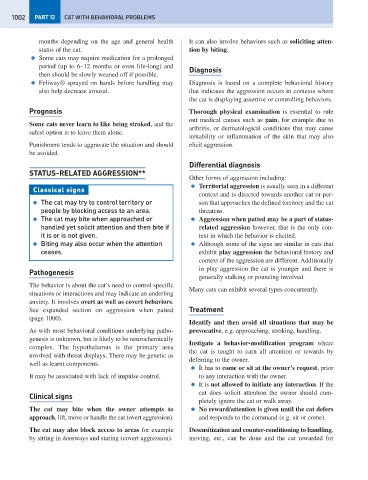Page 1010 - Problem-Based Feline Medicine
P. 1010
1002 PART 12 CAT WITH BEHAVIORAL PROBLEMS
months depending on the age and general health It can also involve behaviors such as soliciting atten-
status of the cat. tion by biting.
● Some cats may require medication for a prolonged
period (up to 6–12 months or even life-long) and
Diagnosis
then should be slowly weaned off if possible.
● Feliway® sprayed on hands before handling may Diagnosis is based on a complete behavioral history
also help decrease arousal. that indicates the aggression occurs in contexts where
the cat is displaying assertive or controlling behaviors.
Prognosis Thorough physical examination is essential to rule
out medical causes such as pain, for example due to
Some cats never learn to like being stroked, and the
arthritis, or dermatological conditions that may cause
safest option is to leave them alone.
irritability or inflammation of the skin that may also
Punishment tends to aggravate the situation and should elicit aggression.
be avoided.
Differential diagnosis
STATUS-RELATED AGGRESSION**
Other forms of aggression including:
● Territorial aggression is usually seen in a different
Classical signs
context and is directed towards another cat or per-
● The cat may try to control territory or son that approaches the defined territory and the cat
people by blocking access to an area. threatens.
● The cat may bite when approached or ● Aggression when patted may be a part of status-
handled yet solicit attention and then bite if related aggression however, that is the only con-
it is or is not given. text in which the behavior is elicited.
● Biting may also occur when the attention ● Although some of the signs are similar in cats that
ceases. exhibit play aggression the behavioral history and
context of the aggression are different. Additionally
in play aggression the cat is younger and there is
Pathogenesis
generally stalking or pouncing involved.
The behavior is about the cat’s need to control specific
Many cats can exhibit several types concurrently.
situations or interactions and may indicate an underling
anxiety. It involves overt as well as covert behaviors.
See expanded section on aggression when patted Treatment
(page 1000).
Identify and then avoid all situations that may be
As with most behavioral conditions underlying patho- provocative, e.g. approaching, stroking, handling.
genesis is unknown, but is likely to be neurochemically
Instigate a behavior-modification program where
complex. The hypothalamus is the primary area
the cat is taught to earn all attention or rewards by
involved with threat displays. There may be genetic as
deferring to the owner.
well as learnt components.
● It has to come or sit at the owner’s request, prior
It may be associated with lack of impulse control. to any interaction with the owner.
● It is not allowed to initiate any interaction. If the
cat does solicit attention the owner should com-
Clinical signs
pletely ignore the cat or walk away.
The cat may bite when the owner attempts to ● No reward/attention is given until the cat defers
approach, lift, move or handle the cat (overt aggression). and responds to the command (e.g. sit or come).
The cat may also block access to areas for example Desensitization and counter-conditioning to handling,
by sitting in doorways and staring (covert aggression). moving, etc., can be done and the cat rewarded for

